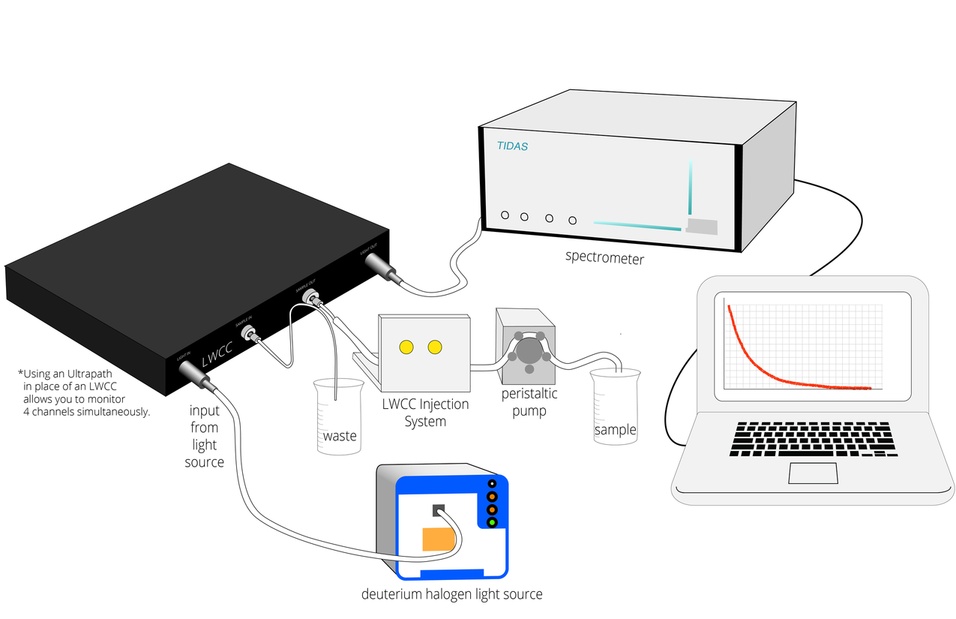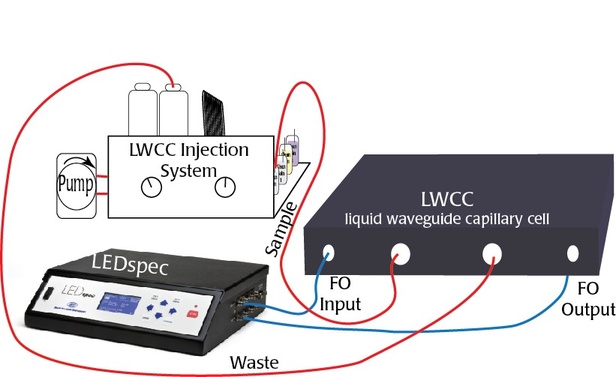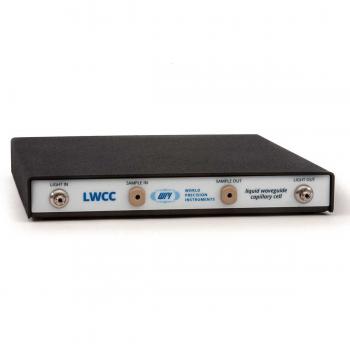/ Catalog / Spectroscopy / Liquid Waveguide Capillary Cell
Liquid Waveguide Capillary Cell - 50, 100, 250, 500 cm pathlengths
WPI Series LWCC3XXX liquid waveguide capillary cells have a path length of 50, 100, 250 or 500 cm. They provide spectroscopic measurement of trace concentrations of dissolved substances due to the increased optical path length.
- Overview
- Specifications
- Links
Microliter Sample Volume - Exceptional Sensitivity
- Optical sample flow cell with a reduced sample capacity and a longer optical route.
- Liquids can be measured continuously or with discrete samples.
- Connects 600um core optical fibers through SMA terminations to fiber optic spectrometers and light sources.
- Efficient measurement of ppb-ppt aqueous samples, which have tiny volumes or concentrations.
- Works with the majority of liquids that have a refractive index above 1.30, with the exception of perfluorinated solvents.
- Low sample concentrations can be found in a lab or industrial environment using absorbance measurements in the UV, VIS, and NIR regions.
Benefits
- Adapts via SMA terminations to the majority of fiber optic detecting systems.
- Efficient measurement of ppb-ppt aqueous samples, which have tiny volumes or concentrations.
- Works with most liquids that have a refractive index of more than 1.30, with the exception of perfluorinated solvents.
- The UV, VIS, and NIR wavelength ranges are all usable for measuring absorbance.
- 20 years of experience in manufacturing.
- Low UV drift
The LWCC connects directly to a pump (e.g.WPI's MINISTAR), a chromatography column, a WPI Sample Injector Assembly (58006), Syringe Adapter Kit (58450), or the LWCC Injection System (89372)
Note: WPI offers the LWCC Start-up Kit (KITLWCC) includes two 1 meter fiber optic cables (505195), Sample Injector Assembly (58006) MiniStar™ Peristaltic Pump (MiniStar), and Waveguide Cleaning Kit (501609)
LWCC Properties
- Total internal reflection at the core/wall contact of a LWCC confines light to the (liquid) core in a manner akin to that of optical fibers.
- Made from fused silica tubing with a low refractive index polymer covering on the outside.
Pressure and Flow Rate
Pressure, the fourth power of the fluid capillary's diameter affect flow in a proportional manner, and it's reciprocal of the capillary's length, and the viscosity of the fluid .
- For a water flow of 1 mL/min through a 1 m of a 55 μm ID waveguide, approximately 1.5 PSI is needed.
- LWCC has been run at 100 to 200 PSI without a problem being noticed.
- The LWCC's maximum hydrostatic pressure tolerance has not been determined.
Applications
- Nutrient traces in saltwater, including nitrite, nitrate, phosphate, and iron
- Oceanographic and environmental monitoring
- Analysis of drinking water
- Coloured dissolved organic matter (CDOM)
- Process control
Beer's Law, which states that the absorbance signal is proportional to chemical concentration, light path length, and the compound's particular molar absorption coefficient, governs UV/VIS/NIR absorbance spectroscopy. Cuvettes and flow cells typically have optical pathlengths of between 0.2 cm and 10 cm. Mechanical limitations make it difficult to create longer pathlengths. This void is filled by liquid waveguide capillary cells (LWCCs). LWCCs are fiber optic flow cells with modest sample volumes ranging from 2.4 µL to around 3 mL with an extended optical pathlength (10-500 cm). With WPI's proprietary aqueous waveguide technology, a 1 mAU signal can be 100 times stronger in a 100 cm flow cell than it would be in a conventional 1 cm cell.*
They can be connected to a spectrophotometer with fiber optic capability via optical fibers. In a laboratory or process control setting, ultra-sensitive absorbance measurements in the ultraviolet (UV), visible (VIS), and near-infrared (NIR) can be used to identify low sample concentrations.
Your Sample Serves as the Center of a Light Guide
The Liquid Waveguide Capillary Cells from WPI are constructed from fused silica tubing and have a low refractive index polymer covering on the outside. Your liquid sample, which serves as the waveguide's central component, is led through the capillary. The inner wall of the fused silica capillary is hydrophilic, which increases signal stability and makes it simple to remove air bubbles that have become trapped in the flow cell. Yet, the intrinsic attenuation of the sample liquid plays a major role in the LWCC's transmission.
Connections
Traditional HPLC type 10-32 coned port fittings with 1/32 inch tubing for the liquid connection and 500 µm SMA fiber optic adapters for light input and output are used in the LWCC-3xxx series of flow cells. The 1/4-28 flangeless flat bottom fittings and 0.125" tubing 600 µm SMA fiber optic adapters are used with the LWCC-4xxx series of flow cells.
The simplest method for pumping liquid into the flow cells is to use a sample injector (58006) and a ministar peristaltic pump (MINISTAR). A fluid injection analysis (FIA) system or a gas segmented fluid injection analysis (GFIA) system may be directly connected to the LWCC or through a debubbler.
When the sample is injected into a constant flow via an injection loop that is 3–4 times the internal flow cell volume, WPI's LWCC Injection system (89372) may be used to route discrete measurements in order to ensure a stable baseline and prevent the introduction of micro air bubbles into the flow cell.

A complete WPI long pathlength liquid absorbance system for trace detection is shown in this illustration.

An injection system, a pump, and a spectrophotometer are common components of a LWCC setup.
You can also visit site of the manufacturer.


